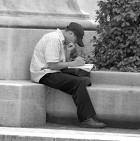
Today, I came across a New York Times article, “The Future of Reading: Students Get New Assignment: Pick Books You Like,” which profiles two teachers who are participating in a growing movement to encourage the love of reading by giving children more freedom to choose which books to read for school. OK, I’ll admit that my first reaction to the headline was sure, next they’ll be asking fifth graders what courses should be taught.
But it’s not that bad. Nancie Atwell, one of the teachers mentioned in the article lets students choose books they want to read, with certain guidelines—no Gossip Girls, no books based on video games. She has the students spend time reading during class time, during which she goes around and talks with the children about the books they are reading. She has them keep journals and report on the books they read.
Part of the process with this program involves teachers nudging the students to read higher quality books. For instance, when one student finished a book, Chaka! Through the Fire, a memoir by singer Chaka Khan, Lorrie McNeill, the other teacher mention in the article, suggested the student might now read Maya Angelou's I Know Why the Caged Bird Sings.
Despite the increased freedom in her classroom, Atwell’s teaching method remains rigorous. Speaking with one boy, she said “I keep trying to get you to read things other than James Patterson,” Ms. Atwell said, pointing to the book he was reading, “But if you are going to write a book review of substance, you are going to have to find substance in the book.”
Not everyone agrees with Atwell’s approach. Most teachers still assign “classic” books, but if one of the goals in education is to encourage lifelong reading, maybe these caring teachers’ approach deserves a try. What do you think about letting students choose what they want to read?
But it’s not that bad. Nancie Atwell, one of the teachers mentioned in the article lets students choose books they want to read, with certain guidelines—no Gossip Girls, no books based on video games. She has the students spend time reading during class time, during which she goes around and talks with the children about the books they are reading. She has them keep journals and report on the books they read.
Part of the process with this program involves teachers nudging the students to read higher quality books. For instance, when one student finished a book, Chaka! Through the Fire, a memoir by singer Chaka Khan, Lorrie McNeill, the other teacher mention in the article, suggested the student might now read Maya Angelou's I Know Why the Caged Bird Sings.
Despite the increased freedom in her classroom, Atwell’s teaching method remains rigorous. Speaking with one boy, she said “I keep trying to get you to read things other than James Patterson,” Ms. Atwell said, pointing to the book he was reading, “But if you are going to write a book review of substance, you are going to have to find substance in the book.”
Not everyone agrees with Atwell’s approach. Most teachers still assign “classic” books, but if one of the goals in education is to encourage lifelong reading, maybe these caring teachers’ approach deserves a try. What do you think about letting students choose what they want to read?

